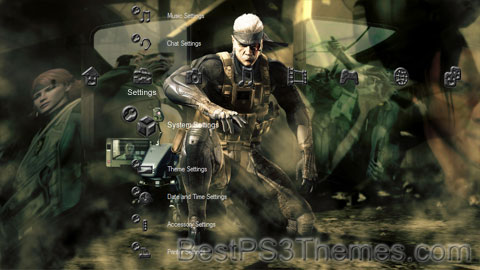Heavenly Sword theme by Kikanny
Download: HeavenlySword_3.p3t
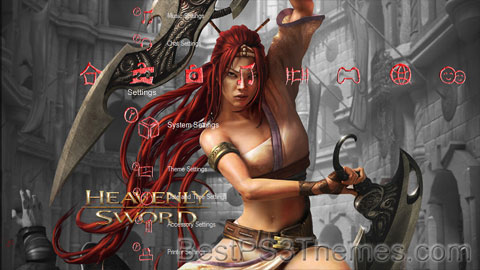
(4 backgrounds)
| Heavenly Sword | |
|---|---|
 European box art showing protagonist Nariko | |
| Developer(s) | Ninja Theory |
| Publisher(s) | Sony Computer Entertainment |
| Director(s) | Nina Kristensen Tameem Antoniades |
| Producer(s) | Mat Hart |
| Artist(s) | Hugues Giboire |
| Writer(s) | Tameem Antoniades Rhianna Pratchett Andy Serkis |
| Composer(s) | Nitin Sawhney |
| Platform(s) | PlayStation 3 |
| Release | |
| Genre(s) | Action-adventure, hack and slash |
| Mode(s) | Single-player |
Heavenly Sword is a 2007 action-adventure hack and slash video game developed by Ninja Theory and published by Sony Computer Entertainment for the PlayStation 3.
Gameplay[edit]
The game is an action-adventure title with heavy elements of hack and slash gameplay. The gameplay of the game resembles a martial arts title focused on melee combat while featuring opportunities for ranged attacks. The main character, Nariko, uses a weapon called the "Heavenly Sword" which changes into one of three forms depending on what attack stance the player uses as part of a unique fighting style. Speed Stance provides an even balance between damage and speed, where the sword takes the form of two separate blades.[1] Range Stance allows fast, long-range, but weaker attacks, with the sword being two blades chained together. Power Stance is the most powerful, but slowest style, where attacks are made with the sword in the shape of one large, two-handed blade.
For exploration and certain battles, the game also makes use of quick time events (QTE). During a QTE, a symbol for a certain button or for an action such as moving the analog stick to the right or left appears on-screen and the player must match what is shown to successfully complete the scene.[1]
In addition to Nariko, a secondary character, Kai, is controlled for some portions of the game.[1] Many of Kai's stages take the form of sniping missions, using her crossbow to pick off enemies, in some cases to protect characters. While Kai cannot perform hand-to-hand combat,[1] in stages that call for her to explore the level she is able to hop over objects and to free herself from an enemy's grasp by temporarily stunning them.
Projectiles can be maneuvered to their targets using the motion-sensing capabilities of the Sixaxis controller through a feature known as Aftertouch. Such projectiles include guiding Kai's arrows after she has launched them, and for Nariko, guiding a cannon or rocket launcher, or picking up and throwing objects.
Plot[edit]
Setting[edit]
The game's story and mythos revolves around the titular Heavenly Sword, a blade said to have been wielded by an unnamed Heavenly deity against a demonic warlord called the Raven Lord.[2] After the battle was won and the Raven Lord defeated, the sword was left in the mortal world, becoming the center of wars over its power.[3] The fighting made the sword lust after the life of its users, eventually killing them after a short time.[4][5] A warrior tribe finally took charge of the sword, ending the wars and pledging to keep it safe and unused for the world's own good.[6] Among the tribe, a legend said that the sword's original wielder would be reborn in the year of the "fire-horse", and that this figure would unite the world's scattered tribes and lead the world to peace.[7]
Characters[edit]
The game's narrator and main protagonist is Nariko (Anna Torv), a headstrong red-headed woman who was born in the year of the prophesied divine warrior: because she was a woman, her clan saw her as a mockery of the prophecy and a portent of doom.[8] The game's main antagonist is King Bohan (Andy Serkis), a tyrannical ruler who is determined to bring the world's tribes to heel and pave the way for a new golden age.[9] Nariko is trained as a warrior by her father, Master Shen (Ewan Stewart), who both cares for her as a child and has difficulty coping with her role in the clan's seeming undoing and the death of his wife.[10] Nariko's only friend is Kai (Lydia Baksh), a wild and erratic young girl who is the last member of a clan destroyed by the armies of Bohan.[11] Among Bohan's servants are his general, Flying Fox (Steven Berkoff): his serpentine mistress Whiptail (Race Davies): and Roach (Richard Ridings), Bohan's son, of whom the king is so ashamed because of Roach's obese appearance that he will not even acknowledge Roach as his own.[12]
Story[edit]
The game begins in medias res, with Nariko fighting the forces of Bohan. As she is fighting the sword finishes draining her life and she seemingly dies, waking in a field and speaking to the power within the sword about what has happened. Five days before, Nariko's clan is assaulted by King Bohan's forces. Before she joins the fight, Shen thrusts the sword into the ground next to her demanding that she take care of it. Nariko fights alongside her father and her clansmen as their defenses are weakened and stretched by scores of Bohan's warriors scaling the city walls accompanied by catapults. As the warriors and Shen escape from Bohan's Army, Nariko protects them until spotting a catapult moving toward the fort. As Shen had earlier instructed her, she flees, as the fortress is apparently destroyed behind her. She passes a large black bird with a golden head, the animal form of the Raven Lord. When Bohan's army captures her father and corners her Nariko has no choice but to wield the sword to defend herself in order to escape. She takes a flying leap off a cliff edge as Bohan's archers begin firing at her. Kai finds Nariko after disobeying Shen's orders to hide and informs her of the temple where her father and clansmen are held captive. Nariko infiltrates the temple and is ambushed by Flying Fox. She defeats the general and continues on to rescue her father. Meanwhile, King Bohan plots to set up a trap for Nariko with Whiptail. Nariko falls into the trap, and Whiptail, after watching most of her personal guards defeated, tells Nariko the truth behind her father's original feelings about her birth - Shen wanted to kill Nariko shortly after her birth, but was unable to bring himself to do so.[13] Nariko tells her father to leave her and fights with Whiptail. After Nariko impales Whiptail with the sword, King Bohan turns up and snaps Whiptail's neck in her dying moments, then captures the sword and an incapacitated Nariko.
As Shen escapes, Kai makes her way to Nariko's cell. Kai is able to find where Nariko is imprisoned and begs that she comes home with her. Nariko explains to Kai that she needs to reacquire the Heavenly Sword to kill King Bohan. She asks Kai to retrieve the sword and Kai accepts the task. Kai succeeds in finding the Heavenly Sword, only to also discover her mother's skeleton. In a flashback, it is revealed that, some years ago, Kai's mother was murdered in front of her eyes by Flying Fox. Returning to the present, Kai is confronted by Flying Fox and barely manages to escape from him with the sword. Meanwhile, Nariko is forced by Bohan to fight before his army against Orangumen, pets of Roach's. During the battle, Kai arrives and throws Nariko the sword. When Nariko defeats all the Orangumen, Bohan orders Roach to murder Nariko. After defeating Roach, both Nariko and Kai flee from the pit. Bohan then commands Flying Fox to kill Kai while his soldiers take on Nariko. As the two try to escape, Flying Fox cuts Kai off from Nariko and they are separated. Nariko desperately tails Flying Fox, but when she finally catches up, he seemingly hangs Kai in front of her. Believing Kai dead, Nariko flies into a rage and battles with Flying Fox. As Nariko and Flying Fox duel, Kai, who survived the drop, uses her crossbow to shoot an arrow into Flying Fox's head, killing him. Nariko releases the injured Kai from the noose and returns her to the care of the clan.
King Bohan rallies his men to launch a final attack to regain the Heavenly Sword. Nariko fights alongside her father and clansmen once more. Nariko kills countless numbers of Bohan's troops with ease and destroys his catapults. Despite her efforts, the sword kills her, bringing the events of the game full circle. But this time, Nariko reverses her death by making a pact with the sword to protect it from becoming a useless and dusty relic, since it needs her more than her clan needs it.[14] Nariko returns as a goddess-like figure, and proceeds to slaughter Bohan's troops. Desperate, Bohan begs the Raven Lord (who has been seen repeatedly throughout the game watching Nariko or being with Bohan) to give him the power to destroy Nariko. Bohan gets his wish and the Raven Lord merges with him.[15] An epic battle ensues similar to the one foretold in the prophecy. After Nariko manages to defeat Bohan, the raven leaves his body, and, despite Bohan begging for mercy, pecks his eyes out and flies away.
As Nariko raises the sword to strike the final blow, Roach comes to his father's side and begs Nariko to let him take Bohan. Nariko relents, then Roach and Bohan leave, with Bohan calling Roach his son for the first time.[16] Though successful in protecting the sword from coming into the hands of Bohan, Nariko still must give her life for wielding it, for that is the price for using the almighty sword, and the story comes to its end. Nariko reflects that she believes they have fought in vain for the prophecy, that the sword was not from Heaven, but feels gratified that she chose to be the one who was going to save her people from evil: she took the sword, paid the price and ultimately defeated Bohan's army, but nevertheless she was still a normal woman.[17] Nariko heals Kai, and gives her the sword for safekeeping, before passing away. At the funeral, Nariko's body is placed into a boat filled with blossoms, and Kai and Shen cast her out to sea.
Development[edit]
Heavenly Sword began development in 2002.[18] After establishing early concept, a CGI trailer was produced which helped guide future development, described by the team as an iterative process where many other things changed around the central concept. The team began production without a specific console in mind, tailoring gameplay elements to the PlayStation 3 when the game was picked up by Sony as an exclusive for their upcoming platform.[19] The game was developed using Havok Complete, a combination of Havok Physics and Havok Animation.[20] Production began with the aim of telling a cinematic action adventure inspired by recent films including Crouching Tiger, Hidden Dragon and Hero, with a later fantasy influence inspired by the themes of The Lord of the Rings.[21] Other influences included the game Ico (2001), the graphic novel La Tour, and the South Korean movie Musa.[19] The game eventually developed a distinct visual and narrative identity while maintaining elements from these early inspirations.[21] Nariko's three combat styles drew direct inspiration from the dragon forms in Panzer Dragoon Orta (2002).[19]
The character designs were intended to stand out from each other, with distinct elements ranging from color coding to how a character moved. Nariko was made recognisable both with her unique red hair and the simplicity of her outfit compared to other characters.[21] The early concept designs were heavily influenced by Japanese art, and while it retained a strong Far Eastern theme with influences from Japan and China, the team also incorporated references to Mongolian and South American environments and architecture.[19]
Character movement was an important element for the team. Kai's movements were based on several elements, including cats and Princess Mononoke protagonist San.[19] While they were still faced with technical restrictions, the team had access to hardware which better enabled them to realise their world and character design. Ninja Theory collaborated with Peter Jackson's company Wētā FX to create realistic facial expressions both during cutscenes and in gameplay.[21] All of the actors involved in the project had previously been involved in film or television.[19] Actor Andy Serkis performs as the voice and motion capture actor for King Bohan, one of the major characters in Heavenly Sword; he also acts as dramatic director for the game and is one of the writers of the story of the game. Nariko is voiced by Australian actress Anna Torv.[22]
A demo was released to the PlayStation Store on July 26, 2007, featuring a short, cinematic clip at the beginning and two brief enemy battles, lasting approximately five to ten minutes. An eight-second clip of the game was seen in an episode of the TV series Heroes entitled "Parasite", ostensibly being played by Jessica Sanders and her son, Micah. It featured Nariko running across ropes as they were cut by Bohan's soldiers, before landing on the platform to face them.[23] While the episode was broadcast over four months before the actual release of the game, the level displayed remained in the released build, including the rope sequence shown; the icons in the final game used to inform the player which buttons to press were changed from large, central icons as seen in the clip, to be smaller and positioned at the bottom of the screen. Sony and Ninja Theory have made five 'making-of' videos about the production of Heavenly Sword, with each one detailing a certain aspect of the game's production, from music to motion capture. The videos can either be unlocked while playing the game or downloaded from the PlayStation Store.
Soundtrack[edit]
Nitin Sawhney composed the music for the soundtrack. It was performed by the City of Prague Philharmonic Orchestra conducted by Stephen Hussey. Tameem Antoniades of Ninja Theory said "we have our big orchestral soundtrack but we wanted to add a more ethnic element and marry those two together. There are actually very few musicians in the world who are experts in both areas. Nitin Sawhney is one of them."[24] Sawhney stated that his creation of "musical textures take in everything from Hollywood, European and Chinese cinema to Indian and middle eastern instrumentation through the orchestras and soloists hovering between sonic tidal waves and reflective moments of intimate grace."[25]
Related media[edit]
Animated series[edit]

A series of Heavenly Sword animated episodes were released prior to the launch of the game itself, acting as a prologue to the events of the game. The series, which consists of five episodes, was produced by London production company Blinkink and animated by CHASE Animation Studios, headed by Robert Chandler. The videos were made available both online[26] and through the PlayStation Store. The first two videos were also included on the retail version of the game; the latter three videos were not ready in time to be included.[27]
The style of the animated series differs from the graphics of the game itself. The animated series relies on a simple and stylized 2D look, which allowed director Ben Hibon to "create a complete visual re-interpretation of the world and its inhabitants".[28] The videos were produced using a combination of Adobe Photoshop, Flash and After Effects. Initial reference frames were created with Photoshop, which were then animated in Flash and exported as separate layers into After Effects. The layers were composed onto a 3D stage with multiple foreground, middle ground and background elements, which allowed the use of 3D cameras and lighting to give depth and movement to the video.[28]
Film[edit]
A computer generated animated film version was produced by Blockade Entertainment and scripted by writer Todd Farmer. The cast includes Anna Torv as Nariko, Alfred Molina as King Bohan and Thomas Jane as Loki.[29] The film was released on Blu-ray, DVD and on PlayStation Network on September 2, 2014.[30]
Video game appearances[edit]
Nariko appears as a playable character in PlayStation All-Stars Battle Royale, voiced by Jennifer Hale.[31]
Reception[edit]
| Aggregator | Score |
|---|---|
| Metacritic | 79/100[32] |
| Publication | Score |
|---|---|
| Edge | 6/10[33] |
| Electronic Gaming Monthly | 8.33/10[34] |
| Eurogamer | 7/10[35] |
| Famitsu | 30/40[36] |
| Game Informer | 8.75/10[37] |
| GamePro | |
| GameRevolution | B+[39] |
| GameSpot | 8/10[40] |
| GameSpy | |
| GameTrailers | 7.9/10[42] |
| GameZone | 8.8/10[43] |
| IGN | 7/10[44][45] |
| PlayStation: The Official Magazine | 8/10[46] |
| The A.V. Club | C+[47] |
| USA Today |
| Publication | Award |
|---|---|
| GamePro | Editor's Choice[38] |
| OPM (AU) | Silver Award[49] |
Heavenly Sword sold over one million copies by May 2008.[50][51] Tameem Antoniades stated in March 2010 that sales were approximately one-and-a-half million but that the developer did not break even.[52] The game was praised for its graphics[35] and combat system, while criticism stemmed from the short length of the game and lack of online capabilities. It received "generally favorable reviews" according to video game review aggregator Metacritic.[32]
USA Today gave the game nine stars out of ten, saying, "PlayStation 3 fans hungry for more satisfying first-party content from Sony will be satiated with the feverish pace Heavenly Sword provides."[48] Digital Spy gave it four stars out of five, saying, "The lavish sword combat system and the awesome presentation are what make this title a worthy buy. Sony seems to have created this game as a showcase for the PS3 and forgot about getting the gameplay up to scratch. But despite its failings, Heavenly Sword is a great buy for the excellent sword fighting sections and for those who simply want to show their friends just what the PS3 is capable of."[53] The New York Times gave it a favorable review, saying, "The scenery is breathtaking, battles can be exciting, and the intelligent, cruel King Bohan — voiced brilliantly by Andy Serkis (...) — is one of the best video game villains ever. The game is frustrating because it seems as if it should have been a great game and as if its creators tried to make it a great game, but it managed to be only a pretty good one."[54] Maxim gave it a score of six out of ten, saying, "A few of the puzzles are a total bitch, the button-press sequence/finishing moves that the game steals directly from God of War require too much precision, and the sniper sequences wind up being even more tedious than the fighting. It's fun for a little while, and very flashy, but in the end, for everything Heavenly Sword does right, it does two more things wrong."[55] The A.V. Club gave it a C+ and stated that "If Metal Gear Solid and Halo had acting this good, we'd be on to something."[47] In Japan, Famitsu gave the game a score of two sevens and two eights, for a total of 30 out of 40.[36]
During the 11th Annual Interactive Achievement Awards, the Academy of Interactive Arts & Sciences nominated Heavenly Sword in three categories: "Outstanding Character Performance", "Outstanding Achievement in Art Direction", and "Outstanding Achievement in Original Music Composition".[56]
GamesRadar featured Kai in the article "Freakish fashion" in 2007,[57] and Nariko as a "game babe" sex symbol in 2007 and 2009.[58][59] In 2009, MSN featured Nariko in the article "Gaming's Hottest Babes".[60] UGO featured her among the "Top Animated Hotties" in 2008[61] and in their list of the best girls in video games in 2011,[62] and also in the article "11 Strong Gaming Girls We Never Saw Again" in 2010.[63] In 2010, Lisa Foiles of The Escapist ranked Nariko first in the "Top 5 Impractical Female Character Hairstyles".[64] In 2013, she was ranked as the 18th greatest heroine in video game history by Complex.[65]
Cancelled sequel[edit]
According to Ninja Theory co-founder Tameem Antoniades, the story for the sequel has already been written; in fact a whole trilogy is being planned. He stated, "We've had the story for the sequel for a while now. Hopefully, if this game is successful, then there's no reason why there shouldn't be a sequel and we'd very much like to go into that."[66]
In March 2008, it was confirmed that Ninja Theory is not planning to create a sequel for Heavenly Sword, and instead has decided to work on a new project[67] (most likely Enslaved: Odyssey to the West). Sony Computer Entertainment retains the intellectual property of Heavenly Sword, and there is always the possibility of production on a sequel being outsourced to another developer.[68] In June 2008, it was reported that a sequel to Heavenly Sword was in-development at SCE Studio Cambridge, but was canceled due to Sony no longer seeing it as a commercially viable product.[69] Concept art for the title later surfaced in 2012.[70][71]
References[edit]
| Death Note | |||||||||||||||||||||||||||||||||||||||||||||||||||||||||||||||||||||||||||||||||||||||||||||||||||||||||||||||||||||||||||||||||||||||||
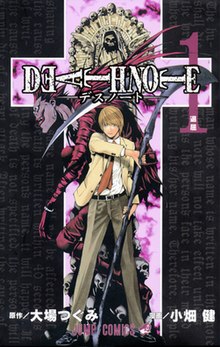 | |||||||||||||||||||||||||||||||||||||||||||||||||||||||||||||||||||||||||||||||||||||||||||||||||||||||||||||||||||||||||||||||||||||||||
| Genre | |||||||||||||||||||||||||||||||||||||||||||||||||||||||||||||||||||||||||||||||||||||||||||||||||||||||||||||||||||||||||||||||||||||||||
|---|---|---|---|---|---|---|---|---|---|---|---|---|---|---|---|---|---|---|---|---|---|---|---|---|---|---|---|---|---|---|---|---|---|---|---|---|---|---|---|---|---|---|---|---|---|---|---|---|---|---|---|---|---|---|---|---|---|---|---|---|---|---|---|---|---|---|---|---|---|---|---|---|---|---|---|---|---|---|---|---|---|---|---|---|---|---|---|---|---|---|---|---|---|---|---|---|---|---|---|---|---|---|---|---|---|---|---|---|---|---|---|---|---|---|---|---|---|---|---|---|---|---|---|---|---|---|---|---|---|---|---|---|---|---|---|---|---|
| Manga | |||||||||||||||||||||||||||||||||||||||||||||||||||||||||||||||||||||||||||||||||||||||||||||||||||||||||||||||||||||||||||||||||||||||||
| Written by | Tsugumi Ohba | ||||||||||||||||||||||||||||||||||||||||||||||||||||||||||||||||||||||||||||||||||||||||||||||||||||||||||||||||||||||||||||||||||||||||
| Illustrated by | Takeshi Obata | ||||||||||||||||||||||||||||||||||||||||||||||||||||||||||||||||||||||||||||||||||||||||||||||||||||||||||||||||||||||||||||||||||||||||
| Published by | Shueisha | ||||||||||||||||||||||||||||||||||||||||||||||||||||||||||||||||||||||||||||||||||||||||||||||||||||||||||||||||||||||||||||||||||||||||
| English publisher | |||||||||||||||||||||||||||||||||||||||||||||||||||||||||||||||||||||||||||||||||||||||||||||||||||||||||||||||||||||||||||||||||||||||||
| Imprint | Jump Comics | ||||||||||||||||||||||||||||||||||||||||||||||||||||||||||||||||||||||||||||||||||||||||||||||||||||||||||||||||||||||||||||||||||||||||
| Magazine | Weekly Shōnen Jump | ||||||||||||||||||||||||||||||||||||||||||||||||||||||||||||||||||||||||||||||||||||||||||||||||||||||||||||||||||||||||||||||||||||||||
| Demographic | Shōnen | ||||||||||||||||||||||||||||||||||||||||||||||||||||||||||||||||||||||||||||||||||||||||||||||||||||||||||||||||||||||||||||||||||||||||
| Original run | December 1, 2003 – May 15, 2006 | ||||||||||||||||||||||||||||||||||||||||||||||||||||||||||||||||||||||||||||||||||||||||||||||||||||||||||||||||||||||||||||||||||||||||
| Volumes | 12 | ||||||||||||||||||||||||||||||||||||||||||||||||||||||||||||||||||||||||||||||||||||||||||||||||||||||||||||||||||||||||||||||||||||||||
| |||||||||||||||||||||||||||||||||||||||||||||||||||||||||||||||||||||||||||||||||||||||||||||||||||||||||||||||||||||||||||||||||||||||||
Death Note (stylized in all caps) is a Japanese manga series written by Tsugumi Ohba and illustrated by Takeshi Obata. It was serialized in Shueisha's shōnen manga magazine Weekly Shōnen Jump from December 2003 to May 2006, with its chapters collected in 12 tankōbon volumes. The story follows Light Yagami, a genius high school student who discovers a mysterious notebook: the "Death Note", which belonged to the shinigami Ryuk, and grants the user the supernatural ability to kill anyone whose name is written in its pages. The series centers around Light's subsequent attempts to use the Death Note to carry out a worldwide massacre of individuals whom he deems immoral and to create a crime-free society, using the alias of a god-like vigilante named "Kira", and the subsequent efforts of an elite Japanese police task force, led by enigmatic detective L, to apprehend him.
A 37-episode anime television series adaptation, produced by Madhouse and directed by Tetsurō Araki, was broadcast on Nippon Television from October 2006 to June 2007. A light novel based on the series, written by Nisio Isin, was also released in 2006. Additionally, various video games have been published by Konami for the Nintendo DS. The series was adapted into three live-action films released in Japan in June, November 2006, and February 2008, and a television drama in 2015. A miniseries titled Death Note: New Generation and a fourth film were released in 2016. An American film adaptation was released exclusively on Netflix in August 2017, and a series is reportedly in the works.
Death Note media, except for video games and soundtracks, is licensed and released in North America by Viz Media. The episodes from the anime first appeared in North America as downloadable from IGN before Viz Media licensed it. The series was aired on YTV's Bionix programming block in Canada and on Adult Swim in the United States with a DVD release following. The live-action films briefly played in certain North American theaters, in 2008, before receiving home video releases. By April 2015, the Death Note manga had over 30 million copies in circulation, making it one of the best-selling manga series.
Plot[edit]
In Tokyo, a disaffected high school student named Light Yagami finds the "Death Note", a mysterious black notebook with rules that can end anyone's life in seconds as long as the writer knows both the target's true name and face. Light uses the notebook to kill high-profile criminals and is visited by Ryuk, a "shinigami" and the Death Note's previous owner. Ryuk, invisible to anyone who has not touched the notebook, reveals that he dropped the notebook into the human world out of boredom and is amused by Light's actions.[5]
Global media suggest that a single mastermind is responsible for the mysterious murders and name them "Kira" (キラ, the Japanese transliteration of the word "killer"). Interpol requests the assistance of the enigmatic detective L to assist in their investigation. L tricks Light into revealing that he is in the Kanto region of Japan by manipulating him to kill a decoy. Light vows to kill L, whom he views as obstructing his plans. L deduces that Kira has inside knowledge of the Japanese police investigation, led by Light's father, Soichiro Yagami. L assigns a team of FBI agents to monitor the families of those connected with the investigation and designates Light as the prime suspect. Light graduates from high school to college. L recruits Light into the Kira Task Force.
Actress-model Misa Amane obtains a second Death Note from a shinigami named Rem and makes a deal for shinigami eyes, which reveal the names of anyone whose face she sees, at the cost of half her remaining lifespan. Seeking to have Light become her boyfriend, Misa uncovers Light's identity as the original Kira. Light uses her love for him to his advantage, intending to use Misa's shinigami eyes to discern L's true name. L deduces that Misa is likely the second Kira and detains her. Rem threatens to kill Light if he does not find a way to save Misa. Light arranges a scheme in which he and Misa temporarily lose their memories of the Death Note, and has Rem pass the Death Note to Kyosuke Higuchi of the Yotsuba Group.
With memories of the Death Note erased, Light joins the investigation and, together with L, deduces Higuchi's identity and arrests him. Light regains his memories and uses the Death Note to kill Higuchi, regaining possession of the book. After restoring Misa's memories, Light instructs her to begin killing as Kira, causing L to cast suspicion on Misa. Rem realizes Light's plan to have Misa sacrifice herself to kill L. After Rem kills L, she disintegrates and Light obtains her Death Note. The task force agrees to have Light operate as the new L. The investigation stalls but crime rates continue to drop.
Four years later, cults worshipping Kira have risen. L's potential successors are introduced: Near and Mello. Mello joins the mafia whilst Near joins forces with the US government. Mello kidnaps Director Takimura, who is killed by Light. Mello kidnaps Light's sister and exchanges her for the Death Note, using it to kill almost all of Near's team. A Shinigami named Sidoh goes to Earth to reclaim his notebook and ends up meeting and helping Mello. Light uses the notebook to find Mello's hideout, but Soichiro is killed in the mission. Mello and Near exchange information and Mello kidnaps Mogi and gives him to Near. Kira's supporters attack Near's group, but they escape. Shuichi Aizawa, one of the task force members, becomes suspicious of Light and meets with Near. As suspicion falls again on Misa, Light passes Misa's Death Note to Teru Mikami, a fervent Kira supporter, and appoints newscaster Kiyomi Takada as Kira's public spokesperson. Near has Mikami followed whilst Aizawa's suspicions are confirmed. Realizing that Takada is connected to Kira, Mello kidnaps her. Takada kills Mello but is killed by Light. Near arranges a meeting between Light and the current Kira Task Force members. Light tries to have Mikami kill Near as well as all the task force members, but Mikami's Death Note fails to work, having been replaced with a decoy. Near proves Light is Kira discovering Mikami had not written down Light's name. Light is wounded in a scuffle and begs Ryuk to write the names of everyone present. Ryuk instead writes down Light's name in his Death Note, as he had promised to do the day they met, and Light dies.
One year later, the world has returned to normal and the Kira Taskforce Members are conflicted over whether they made the right decision. Meanwhile, cults continue to worship Kira.
C-Kira (one-shot sequel)[edit]
Three years later, Near, now functioning as the new L, receives word that a new Kira has appeared. Hearing that the new Kira is randomly killing people, Near concludes that the new Kira is an attention-seeker and denounces the new Kira as "boring" and not worth catching. A shinigami named Midora approaches Ryuk and gives him an apple from the human realm, in a bet to see if a random human could become the new Kira, but Midora loses the bet when the human writes his own name in the Death Note after hearing Near's announcement. Ryuk tells Midora that no human would ever surpass Light as the new Kira.
a-Kira (one-shot sequel)[edit]
Another ten years later, Ryuk returns to Earth and gives the Death Note to Minoru Tanaka, the top-scoring student in Japan, hoping that he will follow in Light Yagami's footsteps. On explaining the rules to Minoru, Ryuk is surprised when he returns the notebook and tells him to return it and his memory of their encounter to him in two years' time. Two years later, on receiving the notebook back from Ryuk, Minoru reveals he has no plans to use it himself but rather he plans to auction it off to the governments of the world, with Ryuk's help sending his offer out as "a-Kira", having waited two years until he was old enough to have a bank account to allow his plan to work. Elsewhere, Near (as L) is revealed to be developing technology meant to track and eventually find a method of destroying Shinigami, although it is not yet advanced enough to be useful. After selling the Death Note to U.S. President Donald Trump for a sum that would ensure every Japanese citizen under the age of 60 would be financially set for life, Minoru relinquishes his ownership and memory of his plan to Ryuk, assuring his own anonymity, while Trump is left unable to use the Death Note after the King of Death creates a new rule disallowing the Death Note to be sold, and he secretly returns it to Ryuk. Minoru collapses to the ground in the bank after withdrawing his savings. It is revealed that Ryuk wrote his name in the Death Note next to Light's. He longs for a human who will use the notebook for a longer period of time.
Production[edit]
Development[edit]
The Death Note concept derived from a rather general concept involving Shinigami and "specific rules".[6] Author Tsugumi Ohba wanted to create a suspense series because the genre had some suspense series available to the public. After the publication of the pilot chapter, the series was not expected to receive approval as a serialized comic. Learning that Death Note had received approval and that Takeshi Obata would create the artwork, Ohba said, they "couldn't even believe it".[7] Due to positive reactions, Death Note became a serialized manga series.[8]
"Thumbnails" incorporating dialogue, panel layout and basic drawings were created, reviewed by an editor and sent to Takeshi Obata, the illustrator, with the script finalized and the panel layout "mostly done". Obata then determined the expressions and "camera angles" and created the final artwork. Ohba concentrated on the tempo and the amount of dialogue, making the text as concise as possible. Ohba commented that "reading too much exposition" would be tiring and would negatively affect the atmosphere and "air of suspense". The illustrator had significant artistic licence to interpret basic descriptions, such as "abandoned building",[9] as well as the design of the Death Notes themselves.
When Ohba was deciding on the plot, they visualized the panels while relaxing on their bed, drinking tea, or walking around their house. Often the original draft was too long and needed to be refined to finalize the desired "tempo" and "flow". The writer remarked on their preference for reading the previous "two or four" chapters carefully to ensure consistency in the story.[6]
The typical weekly production schedule consisted of five days of creating and thinking and one day using a pencil to insert dialogue into rough drafts; after this point, the writer faxed any initial drafts to the editor. The illustrator's weekly production schedule involved one day with the thumbnails, layout, and pencils and one day with additional penciling and inking. Obata's assistants usually worked for four days and Obata spent one day to finish the artwork. Obata said that when he took a few extra days to color the pages, this "messed with the schedule". In contrast, the writer took three or four days to create a chapter on some occasions, while on others they took a month. Obata said that his schedule remained consistent except when he had to create color pages.[10]
Ohba and Obata rarely met in person during the creation of the serialized manga; instead, the two met with the editor. The first time they met in person was at an editorial party in January 2004. Obata said that, despite the intrigue, he did not ask his editor about Ohba's plot developments as he anticipated the new thumbnails every week.[7] The two did not discuss the final chapters with one another and continued talking only with the editor. Ohba said that when they asked the editor if Obata had "said anything" about the story and plot, the editor responded: "No, nothing".[9]
Ohba claims that the series ended more or less in the manner that they intended for it to end; they considered the idea of L defeating Light Yagami with Light dying but instead chose to use the "Yellow Box Warehouse" ending. According to Ohba, the details had been set "from the beginning".[8] The writer wanted an ongoing plot line instead of an episodic series because Death Note was serialized and its focus was intended to be on a cast with a series of events triggered by the Death Note.[11] 13: How to Read states that the humorous aspects of Death Note originated from Ohba's "enjoyment of humorous stories".[12]
When Ohba was asked, during an interview, whether the series was meant to be about enjoying the plot twists and psychological warfare, Ohba responded by saying that this concept was the reason why they were "very happy" to place the story in Weekly Shōnen Jump.[10]
Concepts[edit]
The notebooks[edit]
The core plot device of the story is the "Death Note" itself, a black notebook with instructions (known as "Rules of the Death Note") written on the inside. When used correctly, it allows anyone to commit a murder, knowing only the victim's name and face. According to the director of the live-action films, Shusuke Kaneko, "The idea of spirits living in words is an ancient Japanese concept.... In a way, it's a very Japanese story".[13]
Artist Takeshi Obata originally thought of the books as "Something you would automatically think was a Death Note". Deciding that this design would be cumbersome, he instead opted for a more accessible college notebook. Death Notes were originally conceived as changing based on time and location, resembling scrolls in ancient Japan, or the Old Testament in medieval Europe. However, this idea was never used.[14]
Themes[edit]
Writer Tsugumi Ohba had no particular themes in mind for Death Note. When pushed, he suggested: "Humans will all eventually die, so let's give it our all while we're alive".[15] In a 2012 paper, author Jolyon Baraka Thomas characterised Death Note as a psychological thriller released in the wake of the 1995 Tokyo subway sarin attack, saying that it examines the human tendency to express itself through "horrific" cults.[16]
Pilot chapter[edit]
The Death Note process began when Ohba brought thumbnails for two concept ideas to Shueisha; Ohba said that the Death Note pilot, one of the concepts, was "received well" by editors and attained positive reactions from readers.[8] Ohba described keeping the story of the pilot to one chapter as "very difficult", declaring that it took over a month to begin writing the chapter. He added that the story had to revive the killed characters with the Death Eraser and that he "didn't really care" for that plot device.[17]
Obata said that he wanted to draw the story after he heard of a "horror story featuring shinigami".[7] According to Obata, when he first received the rough draft created by Ohba, he "didn't really get it" at first, and he wanted to work on the project due to the presence of shinigami and because the work "was dark".[17] He also said he wondered about the progression of the plot as he read the thumbnails, and if Jump readers would enjoy reading the comic. Obata said that while there is little action and the main character "doesn't really drive the plot", he enjoyed the atmosphere of the story. He stated that he drew the pilot chapter so that it would appeal to himself.[17]
Ohba brought the rough draft of the pilot chapter to the editorial department. Obata came into the picture at a later point to create the artwork. They did not meet in person while creating the pilot chapter. Ohba said that the editor told him he did not need to meet with Obata to discuss the pilot; Ohba said "I think it worked out all right".[7]
Anime adaptation[edit]
Tetsurō Araki, the director, said that he wished to convey aspects that "made the series interesting" instead of simply "focusing on morals or the concept of justice". Toshiki Inoue, the series organizer, agreed with Araki and added that, in anime adaptations, there is a lot of importance in highlighting the aspects that are "interesting in the original". He concluded that Light's presence was "the most compelling" aspect; therefore the adaptation chronicles Light's "thoughts and actions as much as possible". Inoue noted that to best incorporate the manga's plot into the anime, he "tweak[ed] the chronology a bit" and incorporated flashbacks that appear after the openings of the episodes; he said this revealed the desired tensions. Araki said that, because in an anime the viewer cannot "turn back pages" in the manner that a manga reader can, the anime staff ensured that the show clarified details. Inoue added that the staff did not want to get involved with every single detail, so the staff selected elements to emphasize. Due to the complexity of the original manga, he described the process as "definitely delicate and a great challenge". Inoue admitted that he placed more instructions and notes in the script than usual. Araki added that because of the importance of otherwise trivial details, this commentary became crucial to the development of the series.[18]
Araki said that when he discovered the Death Note anime project, he "literally begged" to join the production team; when he joined he insisted that Inoue should write the scripts. Inoue added that, because he enjoyed reading the manga, he wished to use his effort.[18]
Media[edit]
Manga[edit]
Death Note, written by Tsugumi Ohba and illustrated by Takeshi Obata, was serialized in Shueisha's shōnen manga magazine Weekly Shōnen Jump from December 1, 2003,[19][20] to May 15, 2006.[b][20] The series' 108 chapters were collected into twelve tankōbon volumes by Shueisha, released from April 2, 2004,[23] to July 4, 2006.[24] A one-shot chapter, titled "C-Kira" (Cキラ編, C-Kira-hen) ("Death Note: Special One-Shot"), was published in Weekly Shōnen Jump on February 9, 2008. Set two years after the manga's epilogue, it sees the introduction of a new Kira and the reactions of the main characters in response to the copycat's appearance.[25] Several Death Note yonkoma (four-panel comics) appeared in Akamaru Jump. The yonkoma was written to be humorous. The Akamaru Jump issues that printed the comics include 2004 Spring, 2004 Summer, 2005 Winter, and 2005 Spring. In addition Weekly Shōnen Jump Gag Special 2005 included some Death Note yonkoma in a Jump Heroes Super 4-Panel Competition.[17] Shueisha re-released the series in seven bunkoban volumes from March 18 to August 19, 2014.[26][27] On October 4, 2016, all 12 original manga volumes and the February 2008 one-shot were released in a single All-in-One Edition, consisting of 2,400 pages in a single book.[28][29]
In April 2005, Viz Media announced that they had licensed the series for English release in North America.[30] The twelve volumes were released from October 10, 2005, to July 3, 2007.[31][32] The manga was re-released in a six-volume omnibus edition, dubbed "Black Edition".[33][34] The volumes were released from December 28, 2010, to November 1, 2011.[35][36] The All-in-One Edition was released in English on September 6, 2017, resulting in the February 2008 one-shot being released in English for the first time.[37]
In addition, a guidebook for the manga was also released on October 13, 2006. It was named Death Note 13: How to Read and contained data relating to the series, including character profiles of almost every character that is named, creator interviews, behind the scenes info for the series and the pilot chapter that preceded Death Note. It also reprinted all of the yonkoma serialized in Akamaru Jump and the Weekly Shōnen Jump Gag Special 2005.
Clan SWA theme by SWA Obi-Wan Download: ClanSWA.p3t P3T Unpacker v0.12 This program unpacks Playstation 3 Theme files (.p3t) so that you can touch-up an existing theme to your likings or use a certain wallpaper from it (as many themes have multiple). But remember, if you use content from another theme and release it, be sure to give credit! Download for Windows: p3textractor.zip Instructions: Download p3textractor.zip from above. Extract the files to a folder with a program such as WinZip or WinRAR. Now there are multiple ways to extract the theme. The first way is to simply open the p3t file with p3textractor.exe. If you don’t know how to do this, right click the p3t file and select Open With. Alternatively, open the p3t file and it will ask you to select a program to open with. Click Browse and find p3textractor.exe from where you previously extracted it to. It will open CMD and extract the theme to extracted.[filename]. After that, all you need to do for any future p3t files is open them and it will extract. The second way is very simple. Just drag the p3t file to p3textractor.exe. It will open CMD and extract the theme to extracted.[filename]. For the third way, first put the p3t file you want to extract into the same folder as p3textractor.exe. Open CMD and browse to the folder with p3extractor.exe. Enter the following: Eye of Judgment (Judgement) Earth theme by Xehos Download: EyeofJudgmentEarth.p3t P3T Unpacker v0.12 This program unpacks Playstation 3 Theme files (.p3t) so that you can touch-up an existing theme to your likings or use a certain wallpaper from it (as many themes have multiple). But remember, if you use content from another theme and release it, be sure to give credit! Download for Windows: p3textractor.zip Instructions: Download p3textractor.zip from above. Extract the files to a folder with a program such as WinZip or WinRAR. Now there are multiple ways to extract the theme. The first way is to simply open the p3t file with p3textractor.exe. If you don’t know how to do this, right click the p3t file and select Open With. Alternatively, open the p3t file and it will ask you to select a program to open with. Click Browse and find p3textractor.exe from where you previously extracted it to. It will open CMD and extract the theme to extracted.[filename]. After that, all you need to do for any future p3t files is open them and it will extract. The second way is very simple. Just drag the p3t file to p3textractor.exe. It will open CMD and extract the theme to extracted.[filename]. For the third way, first put the p3t file you want to extract into the same folder as p3textractor.exe. Open CMD and browse to the folder with p3extractor.exe. Enter the following: Eye of Judgment (Judgement) Biolith theme by Xehos Download: EyeofJudgmentBiolith.p3t P3T Unpacker v0.12 This program unpacks Playstation 3 Theme files (.p3t) so that you can touch-up an existing theme to your likings or use a certain wallpaper from it (as many themes have multiple). But remember, if you use content from another theme and release it, be sure to give credit! Download for Windows: p3textractor.zip Instructions: Download p3textractor.zip from above. Extract the files to a folder with a program such as WinZip or WinRAR. Now there are multiple ways to extract the theme. The first way is to simply open the p3t file with p3textractor.exe. If you don’t know how to do this, right click the p3t file and select Open With. Alternatively, open the p3t file and it will ask you to select a program to open with. Click Browse and find p3textractor.exe from where you previously extracted it to. It will open CMD and extract the theme to extracted.[filename]. After that, all you need to do for any future p3t files is open them and it will extract. The second way is very simple. Just drag the p3t file to p3textractor.exe. It will open CMD and extract the theme to extracted.[filename]. For the third way, first put the p3t file you want to extract into the same folder as p3textractor.exe. Open CMD and browse to the folder with p3extractor.exe. Enter the following: Macintosh theme by Tyler Senn Download: Macintosh.p3t Redirect to: Eye of Judgment (Judgement) Water theme by Xehos Download: EyeofJudgmentWater.p3t P3T Unpacker v0.12 This program unpacks Playstation 3 Theme files (.p3t) so that you can touch-up an existing theme to your likings or use a certain wallpaper from it (as many themes have multiple). But remember, if you use content from another theme and release it, be sure to give credit! Download for Windows: p3textractor.zip Instructions: Download p3textractor.zip from above. Extract the files to a folder with a program such as WinZip or WinRAR. Now there are multiple ways to extract the theme. The first way is to simply open the p3t file with p3textractor.exe. If you don’t know how to do this, right click the p3t file and select Open With. Alternatively, open the p3t file and it will ask you to select a program to open with. Click Browse and find p3textractor.exe from where you previously extracted it to. It will open CMD and extract the theme to extracted.[filename]. After that, all you need to do for any future p3t files is open them and it will extract. The second way is very simple. Just drag the p3t file to p3textractor.exe. It will open CMD and extract the theme to extracted.[filename]. For the third way, first put the p3t file you want to extract into the same folder as p3textractor.exe. Open CMD and browse to the folder with p3extractor.exe. Enter the following: Eye of Judgment (Judgement) Fire theme by Xehos Download: EyeofJudgmentFire.p3t P3T Unpacker v0.12 This program unpacks Playstation 3 Theme files (.p3t) so that you can touch-up an existing theme to your likings or use a certain wallpaper from it (as many themes have multiple). But remember, if you use content from another theme and release it, be sure to give credit! Download for Windows: p3textractor.zip Instructions: Download p3textractor.zip from above. Extract the files to a folder with a program such as WinZip or WinRAR. Now there are multiple ways to extract the theme. The first way is to simply open the p3t file with p3textractor.exe. If you don’t know how to do this, right click the p3t file and select Open With. Alternatively, open the p3t file and it will ask you to select a program to open with. Click Browse and find p3textractor.exe from where you previously extracted it to. It will open CMD and extract the theme to extracted.[filename]. After that, all you need to do for any future p3t files is open them and it will extract. The second way is very simple. Just drag the p3t file to p3textractor.exe. It will open CMD and extract the theme to extracted.[filename]. For the third way, first put the p3t file you want to extract into the same folder as p3textractor.exe. Open CMD and browse to the folder with p3extractor.exe. Enter the following:Clan SWA
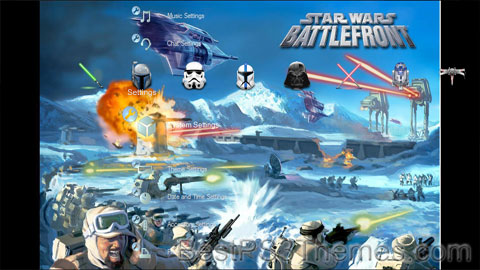
(5 backgrounds)
Copyright (c) 2007. Anoop Menon
p3textractor filename.p3t [destination path]Replace filename with the name of the p3t file, and replace [destination path] with the name of the folder you want the files to be extracted to. A destination path is not required. By default it will extract to extracted.filename.Eye of Judgment Earth
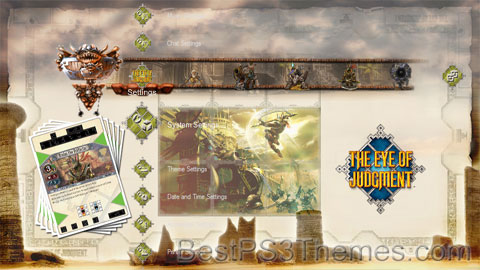
(4 backgrounds)
Copyright (c) 2007. Anoop Menon
p3textractor filename.p3t [destination path]Replace filename with the name of the p3t file, and replace [destination path] with the name of the folder you want the files to be extracted to. A destination path is not required. By default it will extract to extracted.filename.Eye of Judgment Biolith
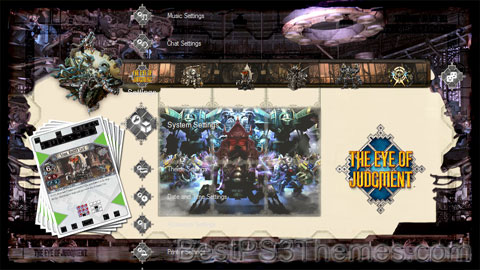
(4 backgrounds)
Copyright (c) 2007. Anoop Menon
p3textractor filename.p3t [destination path]Replace filename with the name of the p3t file, and replace [destination path] with the name of the folder you want the files to be extracted to. A destination path is not required. By default it will extract to extracted.filename.Macintosh
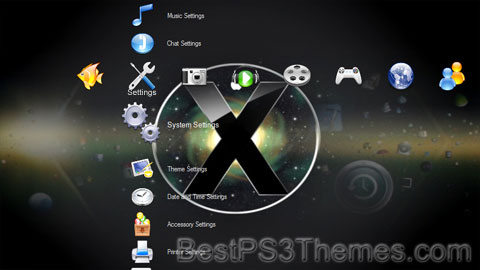
(4 backgrounds)
Eye of Judgment Water
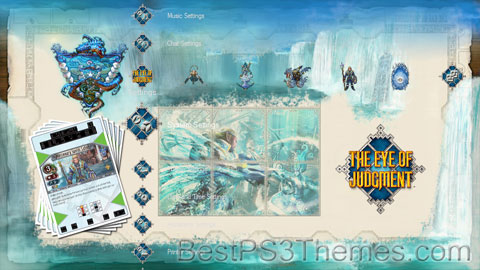
(4 backgrounds)
Copyright (c) 2007. Anoop Menon
p3textractor filename.p3t [destination path]Replace filename with the name of the p3t file, and replace [destination path] with the name of the folder you want the files to be extracted to. A destination path is not required. By default it will extract to extracted.filename.Metal Gear Solid 4 #8
Eye of Judgment Fire
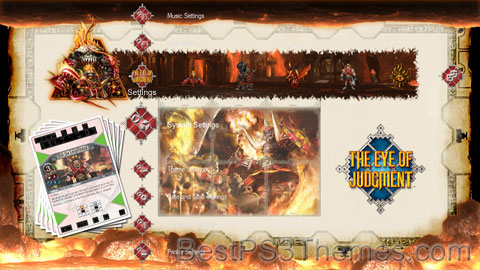
(4 backgrounds)
Copyright (c) 2007. Anoop Menon
p3textractor filename.p3t [destination path]Replace filename with the name of the p3t file, and replace [destination path] with the name of the folder you want the files to be extracted to. A destination path is not required. By default it will extract to extracted.filename.

